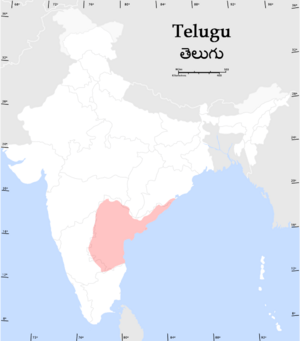Telugu facts for kids
Quick facts for kids Telugu |
||||
|---|---|---|---|---|
| తెలుగు | ||||
 |
||||
| Native to | India worldwide diaspora |
|||
| Region | Andhra Pradesh, Telangana, Chhattisgarh, Karnataka, Odisha, Tamil Nadu, Puducherry, West Bengal | |||
| Native speakers | 76 million (2007) | |||
| Language family |
Dravidian
|
|||
| Writing system | Telugu alphabet (Brahmic) Telugu Braille |
|||
| Official status | ||||
| Official language in | ||||

Distribution of native Telugu speakers in India (as of 1961)
|
||||
|
|
||||
Telugu (తెలుగు) is a language from India. It is mainly spoken in the southern part of the country. Telugu is an official language in the Indian states of Andhra Pradesh and Telangana. It is also one of the 22 official languages recognized by the government of India. Telugu is the second most spoken language in India. It is also the 15th most spoken language in the world! Because it is so old, the Indian government has given Telugu the special status of a "Classical language."
Telugu has a long history. It is mentioned in ancient Indian writings like the Aitereya Brahmanyam, which is part of the Rigveda. This literature dates back thousands of years! According to old stories, a king named Andhra ruled the Telugu region long before the famous epics Ramayana and Mahabharata.
Telugu is special because it has a unique literary game called Avadhana. This game involves performing many tasks at once, like solving puzzles or writing poems, all while listening to different questions. It's a very old tradition that has mostly disappeared in other languages.
A famous king named Krishnadevaraya once said, "Desa bhashalandu Telugu Lessa." This means "Among the nation's languages, Telugu is the best." In the 1800s, British writers called Telugu the "Italian of the East." This was because of how smooth and musical the language sounds. It is believed that an Italian explorer, Niccolò de' Conti, who visited India in the 1400s, first used this phrase.
Telugu belongs to the Dravidian languages family. This family includes about 24 languages spoken across South Asia. Telugu is the most widely spoken language in this group.
Contents
Where People Speak Telugu
Telugu is mostly spoken in the Indian states of Andhra Pradesh and Telangana. You can also find many Telugu speakers in nearby states like Tamil Nadu, Karnataka, Maharashtra, and Odisha.
Many Telugu speakers also live outside India. Large communities can be found in the United States, Australia, New Zealand, Canada, Malaysia, Singapore, and the United Kingdom. People who speak Telugu often move to other countries for education and work. They form strong communities around the world.
Telugu Sounds and Letters
The Telugu alphabet is very rich. It has 56 letters, which include 16 vowels and 36 consonants. Every word in Telugu ends with a vowel sound. This is one reason why the language sounds so musical.
Vowels (Achchulu)
అ ఆ ఇ ఈ ఉ ఊ ఋ ౠ ఎ ఏ ఐ ఒ ఓ ఔ అం అః
Consonants (Hallulu)
క ఖ గ ఘ ఙ
చ ఛ జ ఝ ఞ
ట ఠ డ ఢ ణ
త థ ద ధ న
ప ఫ బ భ మ
య ర ల వ శ
ష స హ ళ క్ష ఱ
Numbers (Ankelu)
౧ ౨ ౩ ౪ ౫ ౬ ౭ ౮ ౯ ౧౦

